
| ||||
|---|---|---|---|---|
 |
 |
 |
 |
 |



























| ||||
|---|---|---|---|---|
 |
 |
 |
 |
 |


























1952 Topps “Wings” (R707-4)
Topps Chewing Gum, Brooklyn, New York, USA
Series Title: Wings
ACC No.: R707-4
Manufactured by: Topps Chewing Gum, Brooklyn, New York, USA
Number of Cards: 200
Numbering; 1 to 200
Card Dimensions: 2⅝ × 3¾ inches
Circa: 1952
Checklist: Download
![Typical 1952 Topps “Wings” R707-4 Card Front [Ref. 1]](https://www.skytamer.com/archive-thumbs/TC/R707-4/600/Front.jpg)
![Typical 1952 Topps “Wings” R707-4 Card Back [Ref. 1]](https://www.skytamer.com/archive-thumbs/TC/R707-4/600/Back.jpg)
Overview
The following overview article is from The Modern Hobby Guide to Topps Chewing Gum: 1938 to 1956 by David Hornish. [2]
“Wings” was the second Giant Size set issued by Topps, right in the midst of the 1952 Baseball cards retail blitz. Hugely popular, the set’s 200 cards feature a sweeping array of aircraft, mostly planes, displayed in colorful, if slightly muted tones. The fronts feature the aircraft’s name in a large font together with some military affiliation information in a black text box below. Reverses feature a large card number, a block of text, some statistics about the craft presented in a fashion similar to the stats on the 1952 baseball cards and a feature called “Friend or Foe”, which displayed silhouettes of planes and played on the fact the nation was still at war. The backs also have the usual T.C.G. copyright, a 1952 date and a “Courtesy Herald Tribune, Inc.” credit line, presumably for the text.
Dating of the set has been the subject of much debate in the hobby over the years but the boxes bear a 1952 copyright. However, a period photo exists showing a single box of “Wings” cards bearing a sticker stating “New Series” being sold alongside 3rd series packs of 1953 Topps baseball cards, which dates around the spring of 1953; indeed the 1953 American Card Catalog, published in February of that year, lists the set at 200 cards. It seems clear then that all 200 cards of Wings came out in 1952. The last 100 cards were seemingly sold in groups of 50, with some first series cards seeded into the nickel and dime packs.
Topps though, was playing games at this time with some of their multi-series sets and skip numbered a couple of cards in series two. These gaps would, in theory, keep the kids buying the cards looking for numbers in series 2 that did not yet exist. This “skip number” marketing was first identified in an article by Pete D’Luhosch at his PJD Enterprises site which details how the quiz on the first series backs always refer to the next card numerically in the set.
Furthermore, the article describes how the first 100 cards have the quiz sequentially referring to the next card in all 100 instances (#100 refers to #1), with the cards from #101-150 have answers scattered over the fifty possible numbers in series two, with the exception of two cards: #118 refers to an answer on #180, while #149 lists #173 as having the answer. In addition, the author has observed that #128 refers to #151 for its quiz answer. Then, within the run from #151-200: #151 lists #110 as its answer while #152 refers to an answer on #125. No corresponding third card in series three referring back to an answer in series two exists so one of the duplicate answers must have taken its place.
D’Luhosch later writes in an article in The Wrapper, that examination of partial uncut sheets shows the 3rd series runs from #101-152, with nos. 118 and 149 held out and replaced by nos. 151 and 152. The 4th series then runs from #153-200 with nos. 118 and 149 added. Furthermore, the switching of #149 and #151 is confirmed by these partial sheets and it is assumed the switching of #118 and #152 matches up as well as they do not show on the partials.
Some repetition of numbers for the answers also starts popping up in these last two series and the thinking is this all demonstrates how the cards from series two were held back and replaced with series three cards and vice-versa. In addition, this illustrates that two higher series of 50 cards each were printed and distributed. Unopened pack finds have shown too that first series cards were seeded into packs as Topps sold off older cards along with the newer ones.
Things don’t get any simpler when the packaging is examined. In addition to the standard one and five cent gum packs, there are one and two card cello packs plus dime cello packs that held 12 cards. The Non-Sports Bible also states that packs were inserted with Thomas Bon Ton Wieners [9] in 1956 but which packs this refers to is unclear. The cards were also reprinted for a Doeskin Tissues promotion but these have wider side borders and Doeskin copyright information on the backs and are not considered part of the original set. A couple of the subjects were re-purposed later in “Jets” and the 1955 “Hocus Focus” Airplanes subset.
If all of that wasn’t enough, Wings was also fully printed with backs in Spanish, presumably for distribution in Mexico and parts of South America. Argentina seems a likely destination for shipments of “Wings” as there are planes from that country in the set, the only South American country so depicted. These were once hard to find but some quantities have popped up in recent years. The last 100 cards in the Spanish series can also be found without printed fronts; an oddity as there are far too many of these around to merely be proofs. The method of distribution of the Spanish cards is certainly conjectural as well. While these cards may seem odd to the casual observer, the Shorin family was quite comfortable doing business in locations south of the U.S. from their days in the tobacco trade. It would seem though that sales of Spanish “Wings” were poor as Topps did not issue another set in the language until the late 1950’s.
Still not done with Wings, a portion of the set was reissued in 1955 as in-store premiums in wrappers that state “Red Ball Jets”. The manufacturer on these is “Makers of World Famous ‘Bazooka’ Gum” and a premium offer on the wrapper promised an additional 15 cards could be had for a mere dime.
Image-Guide

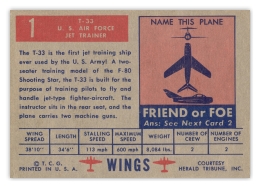

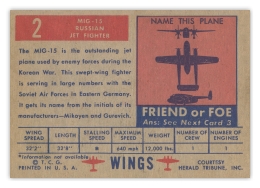



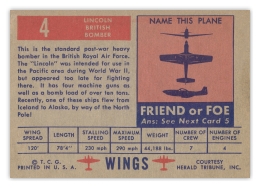

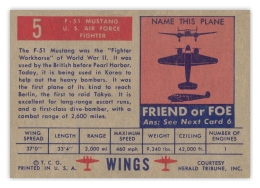

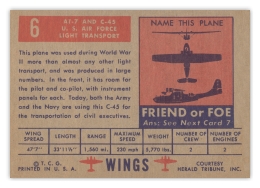

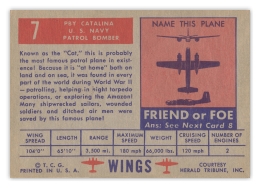



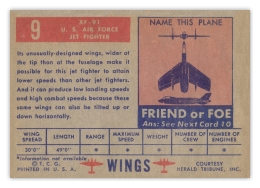

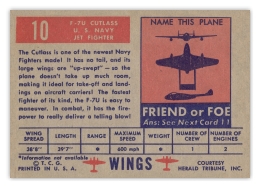

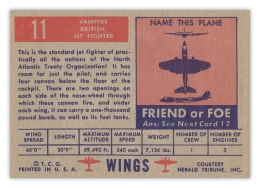



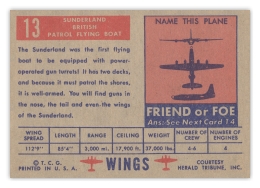







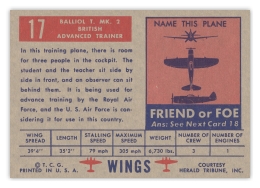

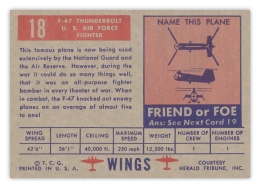

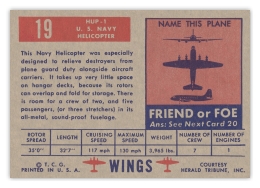

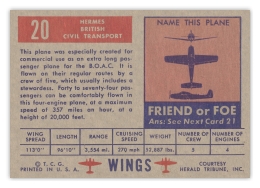

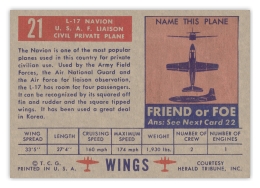

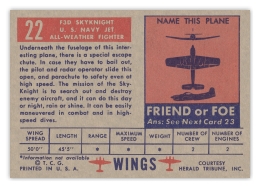

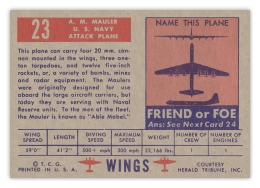



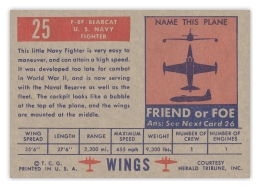

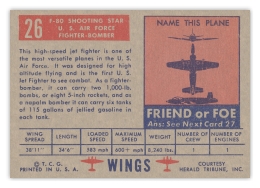

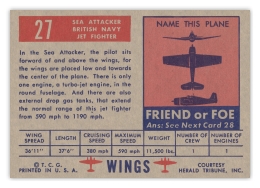

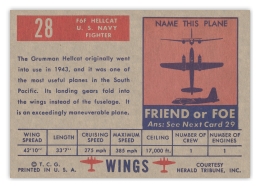

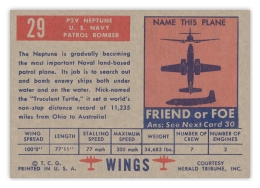

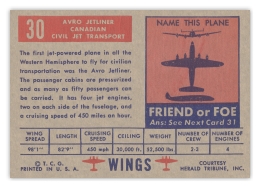

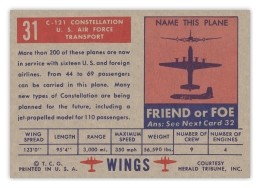

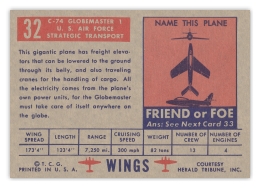





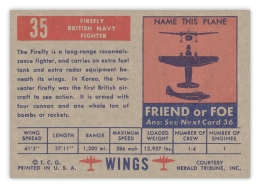



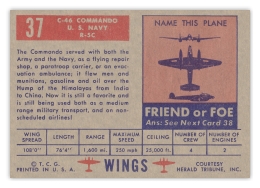

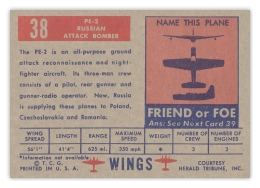



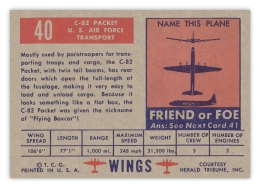



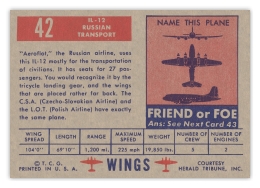



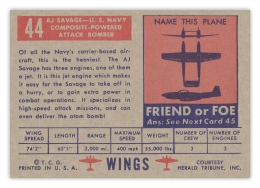



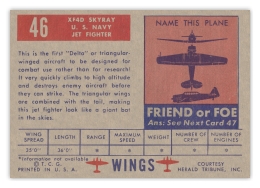



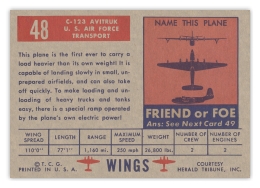



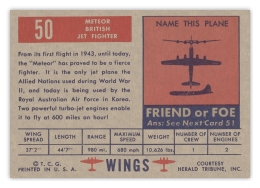

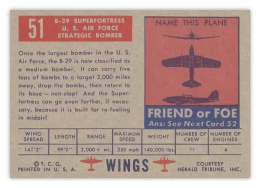

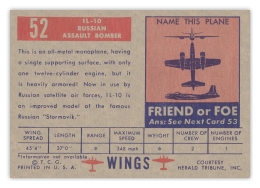





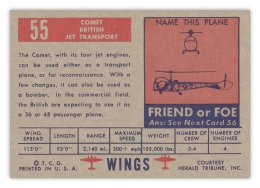



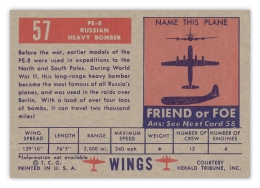







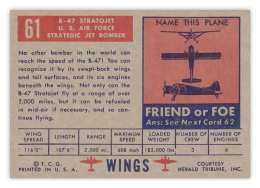







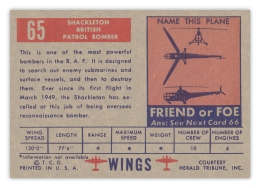

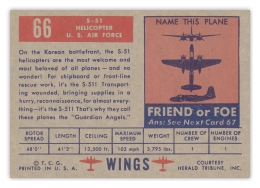





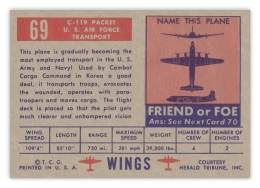

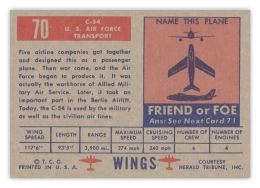





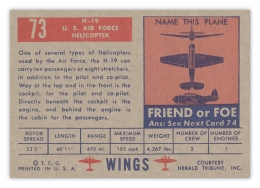



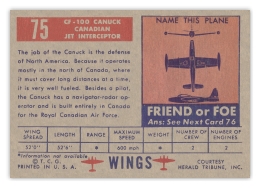

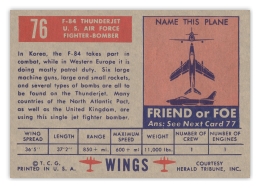



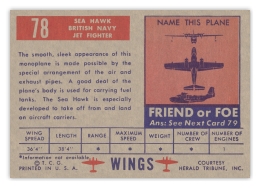







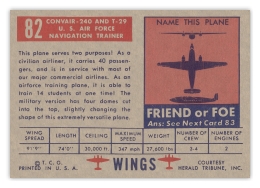

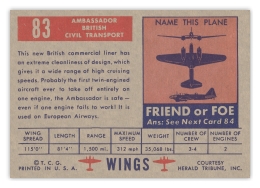



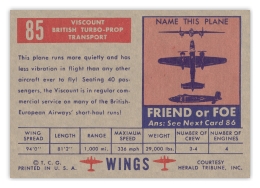

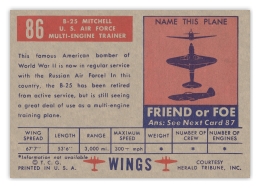



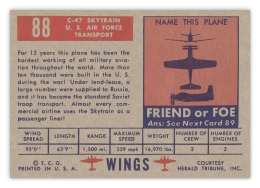

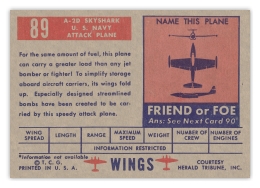

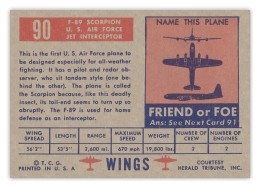



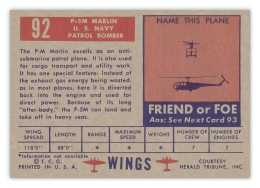

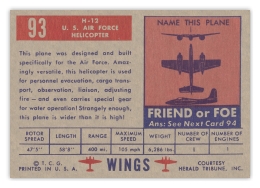



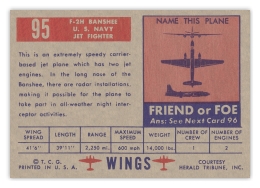





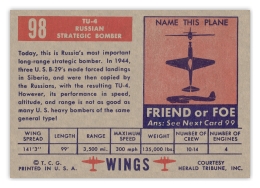

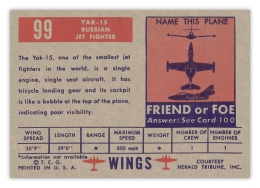







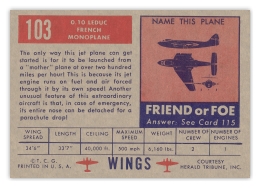

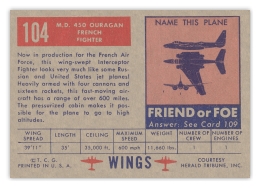

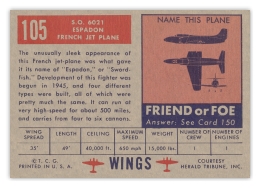

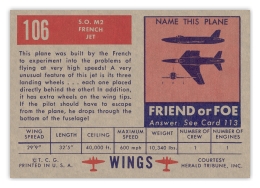

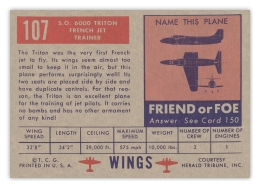

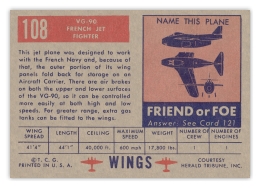



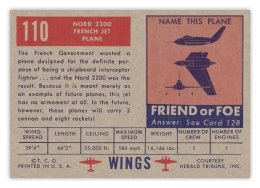



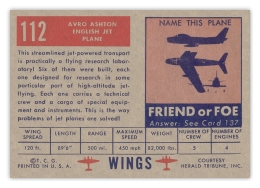

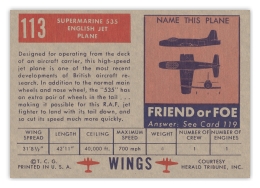



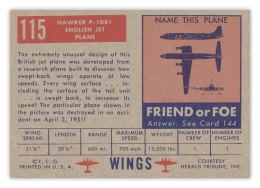

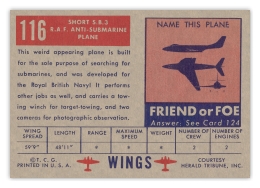

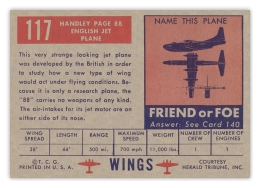

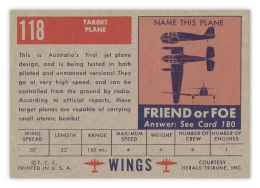

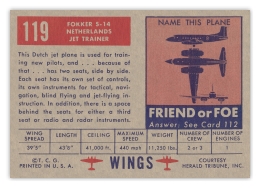



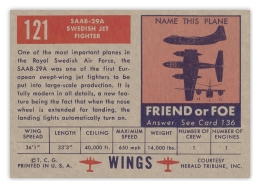

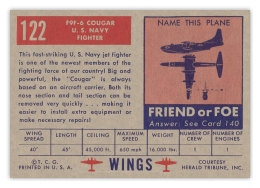

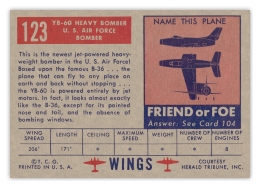

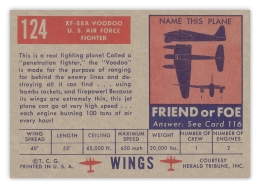



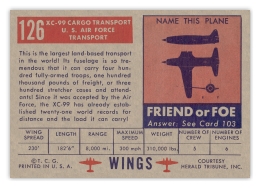

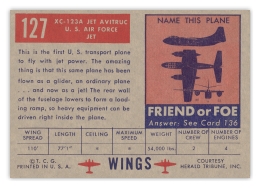

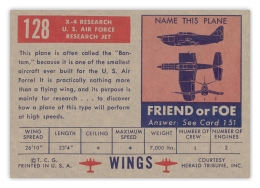

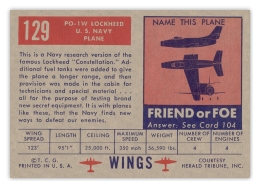

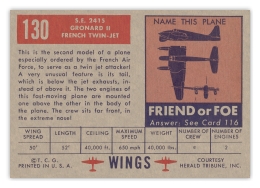

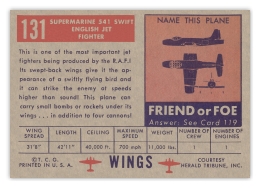

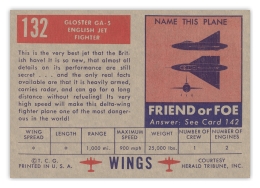

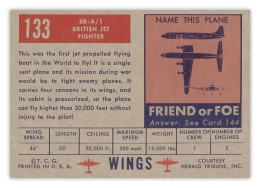

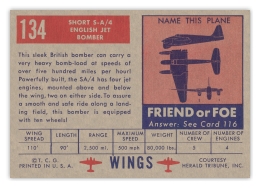

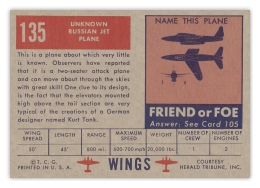

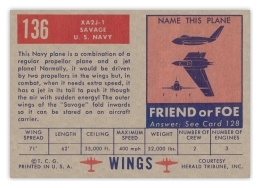

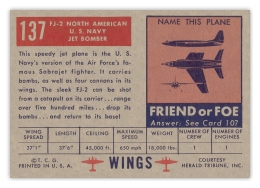

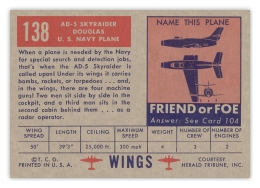

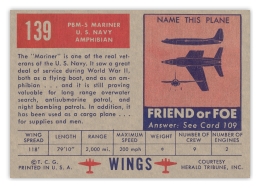

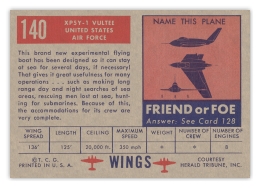



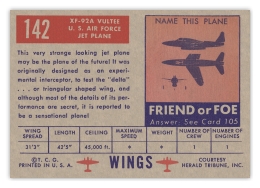

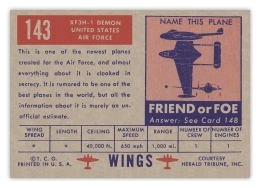

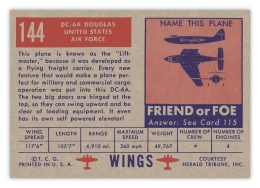

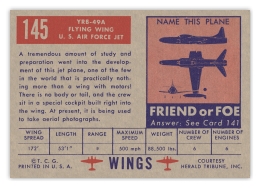

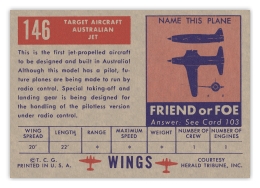



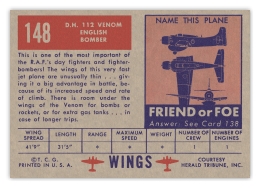

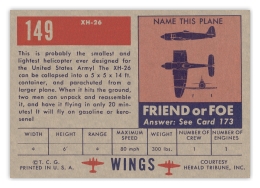



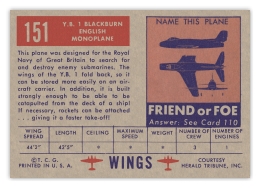

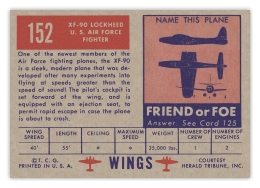

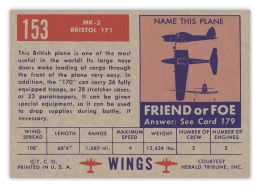



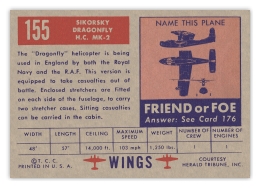

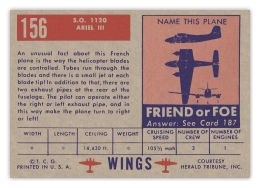

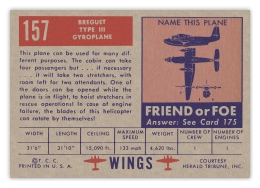

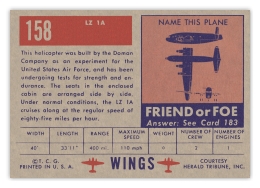

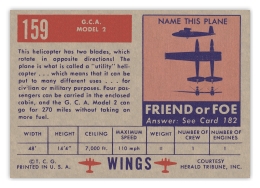

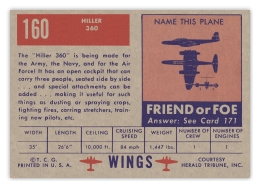

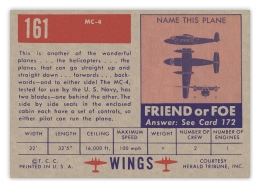

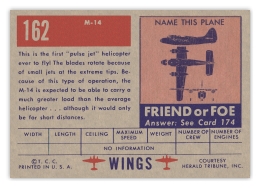

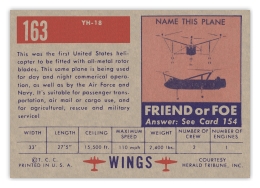

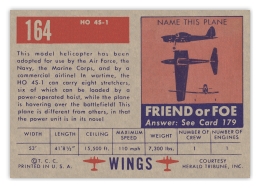

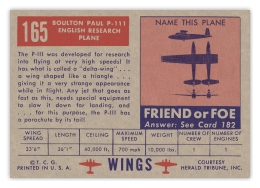

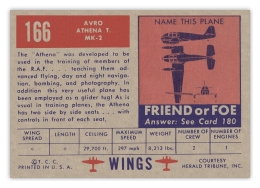

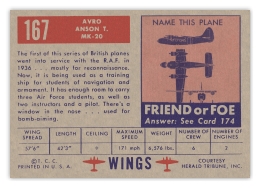

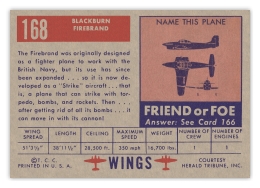



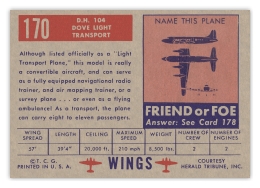

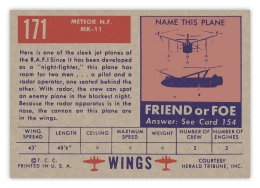

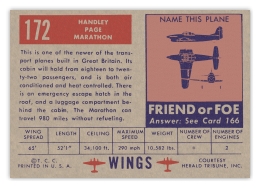

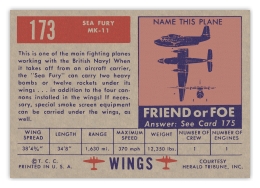

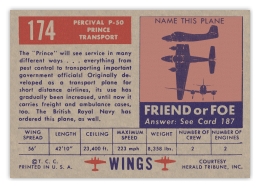





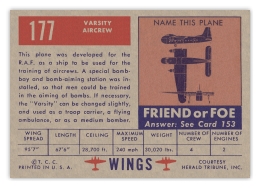

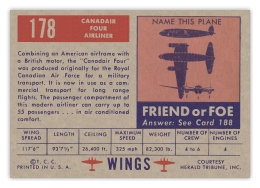



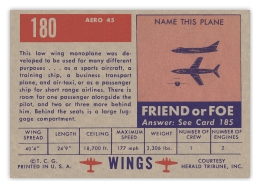

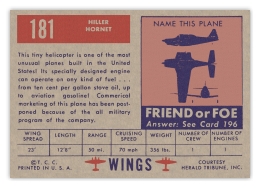



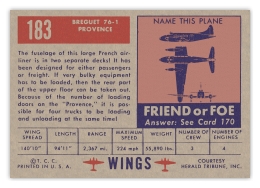

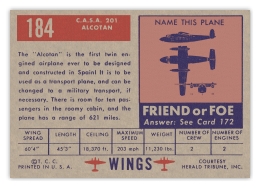

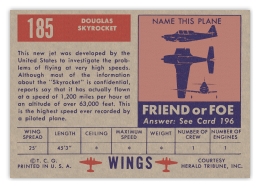



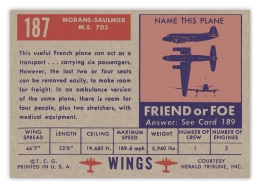



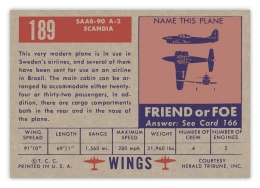

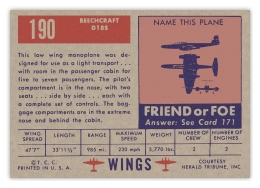

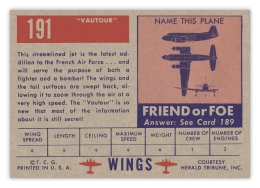



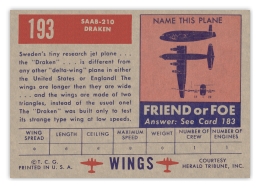



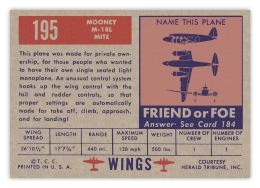

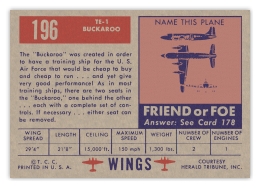

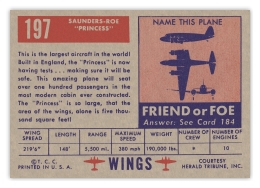

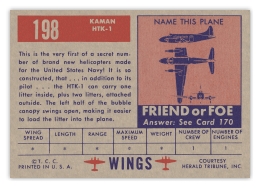

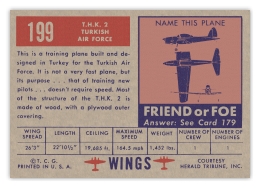


Wrappers and Display Boxes
David Hornish reports in his book “The Modern Hobby Guide to Topps Chewing Gum: 1938 to 1956” [2] that the following seven Wrapper/Pack and three boxes were associated with the Topps R707-4 “Wings” series: (1) 1¢ Wrapper (Glassine); (2) 1¢ Pack (Glassine); (3) 1¢ Pack (1 Card Cello); (4) 1¢ Pack (2 Card Cello); (5) 5¢ Wrapper; (6) 5¢ Pack; (7) 10¢ Pack; (8) 1¢ Box; (9) 5¢ Box; and (10) 10¢ Box. Unfortunately, at this point we do not have images for all of the wrapper/pack/box combinations.
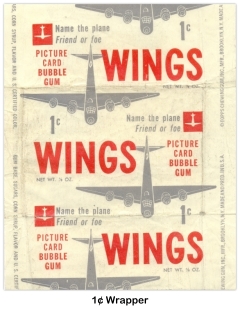


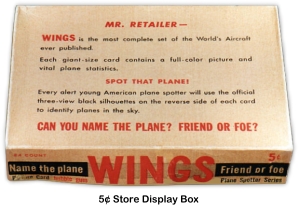

Checklist
| 1952 “Wings” (R707-4)
Topps Chewing Gum Company CHECKLIST | |||||||||||||
|---|---|---|---|---|---|---|---|---|---|---|---|---|---|
| № | x | Card Title | № | x | Card Title | № | x | Card Title | № | x | Card Title | ||
| 1 | T-33 | 51 | B-29 Superfortress | 101 | AE-27 Pulqui | 151 | YB-1 Blackburn | ||||||
| 2 | MiG-15 | 52 | IL-10 | 102 | AE-33 Pulqui II | 152 | XF90 Lockheed | ||||||
| 3 | XC-120 Pack Plane | 53 | B-45 Tornado | 103 | O-10 Leduc | 153 | Bristol 171 Mk-3 | ||||||
| 4 | Lincoln | 54 | LA-5 | 104 | MD-450 Ouragan | 154 | Saro-Cierva Airhorse | ||||||
| 5 | F-51 Mustang | 55 | Comet | 105 | SO-6021 Espadon | 155 | Sikorsky H.C. Mk-2 Dragonfly | ||||||
| 6 | AT-7 Navigator | 56 | H-13D | 106 | SO-M2 | 156 | S.O.1120 Ariel III | ||||||
| 7 | PBY Catalina | 57 | PE-8 | 107 | SO-600 Triton | 157 | Brequet Type III | ||||||
| 8 | B-26 Invader | 58 | C-97 Stratofreighter | 108 | VG-90 | 158 | LZ 1A | ||||||
| 9 | XF-91 | 59 | H-21 | 109 | Nord 1601 | 159 | G.C.A. Model 2 | ||||||
| 10 | F7U Cutlass | 60 | FH-1 Phantom | 110 | Nord 2200 | 160 | Hiller 360 | ||||||
| 11 | Vampire | 61 | B-47 Stratojet | 111 | 707A Delta Wing | 161 | MC-4 | ||||||
| 12 | B-57 Canberra | 62 | L-20 Beaver | 112 | Avro Aston | 162 | M-14 | ||||||
| 13 | Sunderland | 63 | FJ Fury | 113 | Supermarine 535 | 163 | YH-18 | ||||||
| 14 | PB4Y-2 Privateer | 64 | F-94 | 114 | Vickers 660 | 164 | HO4S-1 | ||||||
| 15 | T-28 | 65 | Shackleton | 15 | Hawker P-1081 | 165 | Boulton Paul P-111 | ||||||
| 16 | Wyverne Mk.2 | 66 | S-51 Helicopter | 116 | Short SB-3 | 166 | Avro Athena T.Mk-2 | ||||||
| 17 | Balliol T.Mk.2 | 67 | A-20 Havoc | 117 | Handley Page 88 | 167 | T.Mk-20 Avro Anson | ||||||
| 18 | F-47 Thunderbolt | 68 | IL-2 Stormovik | 118 | Target Plane | 168 | Blackburn Firebrand | ||||||
| 19 | HUP-1 | 69 | C-119 Packet | 119 | Fokker S14 | 169 | Bristol 170 Mk-31 | ||||||
| 20 | Hermes | 70 | DC-4 Skymaster | 120 | MiG-19 | 170 | D.H.104 Dove Light Transport | ||||||
| 21 | L-17 Navion | 71 | F-86 Saber | 121 | SAAB 29A | 171 | Meteor N.F.Mk-11 | ||||||
| 22 | F3D Skynight | 72 | Venom | 122 | F9F6 Cougar | 172 | Handley Page Marathon | ||||||
| 23 | AM Mauler | 73 | H-19 | 123 | YB60 Heavy Bomber | 173 | Sea Fury Mk-11 | ||||||
| 24 | B-36 | 74 | TBM Avenger | 124 | XF 88A Voodoo | 174 | Percival P.50 Prince Transport | ||||||
| 25 | F8F Bearcat | 75 | CF-100 Canuck | 125 | F-84-G Thunderjet | 175 | Short Sealand | ||||||
| 26 | F-80 Shooting Star | 76 | F-84 Thunderjet | 126 | XC-99 Cargo Transport | 176 | Sea Gull | ||||||
| 27 | Sea Attacker | 77 | F-86D | 127 | XC-123A Jet Avitruk | 177 | Varsity Aircrew | ||||||
| 28 | F6F Hellcat | 78 | Sea Hawk | 128 | X-4 Northrop | 178 | Canadair Four | ||||||
| 29 | P2V Neptune | 79 | SA-16 Albatross | 129 | PO-1W Lockheed | 179 | DHC1 Chipmunk | ||||||
| 30 | Avro Jetliner | 80 | 202 | 130 | S.E. 2145 Gronard II | 180 | Aero 45 | ||||||
| 31 | C121 Constellation | 81 | B-50 Superbomber | 131 | Swift Supermarine 541 | 181 | Hiller Hornet | ||||||
| 32 | C-74 Globemaster 1 | 82 | Convair 240 | 132 | Gloster GA5 | 182 | C.M.88-R Gemeaux | ||||||
| 33 | F-84F | 83 | Ambassador | 133 | SR A-1 | 183 | Breguet 76-1 Provence | ||||||
| 34 | F4U Corsair | 84 | IL-4 | 134 | Short SA/4 | 184 | C.A.S.A. 201 Alcotan | ||||||
| 35 | Firefly | 85 | Viscount | 135 | Unknown | 185 | Douglas Skyrocket | ||||||
| 36 | C-125 Raider | 86 | B-25 Mitchell | 136 | XA2J1 Savage | 186 | Fouga C.m.8-R.13 Sylphe | ||||||
| 37 | C-46 Commando | 87 | YAK-3 | 137 | FJ2 North American | 187 | Morane-Saulnier M.S. 703 | ||||||
| 38 | PE-2 | 88 | C-47 Skytrain | 138 | AD-5 Skyraider | 188 | S.O. 30-P Bretagne | ||||||
| 39 | AF Guardian | 89 | A2D Skyshark | 139 | PBM-5 Mariner | 189 | SAAB-90 A-2 Scandia | ||||||
| 40 | C-82 Packet | 90 | F-89 Scorpion | 140 | XP5Y-1 Vultee | 190 | Beechcraft D18S | ||||||
| 41 | R60 Constitution | 91 | IL-18 | 141 | TO-2 Lockheed | 191 | “Vautour” | ||||||
| 42 | IL-2 | 92 | P5M Marlin | 142 | XF-92A Vultee | 192 | C-1 Skimmer | ||||||
| 43 | Hastings | 93 | H-12 | 143 | XF3H-1 Demon | 193 | SAAB-210 Draken | ||||||
| 44 | AJ Savage | 94 | F7F Tigercat | 144 | DC6A Douglas | 194 | CF-100 “Canuck” | ||||||
| 45 | F-82 Twin-Mustang | 95 | F2H Banshee | 145 | YRB-49A Flying Wing | 195 | Mooney M-18L Mite | ||||||
| 46 | XF4D Skyray | 96 | P4M Mercator | 146 | Target Aircraft | 196 | TE-1 Buckaroo | ||||||
| 47 | T-6 Texan | 97 | C-124 Globemaster II | 147 | D.H. Sea Hornet | 197 | Saunders-Roe | ||||||
| 48 | C-123 Avitruk | 98 | TU-4 | 148 | DH112 Venom | 198 | Kaman HTK-1 | ||||||
| 49 | JRM Mars | 99 | YAK-15 | 149 | XH-26 | 199 | T.H.K2 | ||||||
| 50 | Meteor | 100 | F9F Panther | 150 | G-80 | 200 | Fairey “Gyrodene” | ||||||
| Wrappers and Boxes | |||||||||||||
| 1¢ Wrapper (Glassine) | 1¢ Pack (Glassine) | 1¢ Pack (1 Card Cello) | 1¢ Pack (2 Card Cello) | ||||||||||
| 5¢ Wrapper | 5¢ Pack | 10¢ Pack | 1¢ Box | ||||||||||
| 5¢ Box | 10¢ Box | ||||||||||||

Topps Wings; Associated Sets
As mentioned earlier, the Topps R707-4 “Wings” was used in at least four additional marketing schemes: (1) 1956 Bon Ton Wieners “Wings”; (2) Doeskin Tissues “Wings”; (3) Red Ball “Jets”; and (4) the Spanish “Wings” 200 card set. There was also a 50-card smaller sized cards titled “Spot the Plane” that was issued in the UK with “Strato Gum ” from Myers & Metreveli in 1953.
1956 Bon Ton Wieners Wings
Watson’s NSB [6] provides reference to this set with the following statement: “As late as 1956 in food products such as Thomas Bon Ton Wieners (1 pack/package of wieners; cards and wrapper identical to the original issue)”. As of 1/27/2015, that’s all the information that we have about this set. Any help you can provide would certainly be appreciated. Use the “Contact Us ” navigation link on the left to contact us if you have any information to contribute.
Doeskin Wings (F381)
The following overview article is from The Modern Hobby Guide to Topps Chewing Gum: 1938 to 1956 by David Hornish. [2,8]
“Topps struck a deal with Doeskin Tissues in 1955 as that brand made a major relaunch of their product. Cards from Topps R707-4 “Wings” and Topps R714-17 “Rails & Sails” were reprinted on the cardboard that served to stiffen small, personal sized tissue packs. These have elongated side borders as the cards as originally issued were smaller than the stiffeners, so Doeskin cards measure 4⅜ × 2⅝ (67 × 111 mm), although the illustration area is unchanged from the originals.” (5)
![Typical 1955 Doeskin Tissues “Wings” F381 Card Front [Ref. 1]](https://www.skytamer.com/archive-thumbs/TC/F381/600/Front.jpg)
![Typical 1955 Doeskin Tissues “Wings” F381 Card Back [Ref. 1]](https://www.skytamer.com/archive-thumbs/TC/F381/600/Back.jpg)
“The backs are identical to the Topps issues except the “TCG” indicia has been replaced by Doeskin’s. These cards look quite odd when fist encountered and the lack of Topps manufacturing information is curious; perhaps Topps just realized the artwork still had value even if there was abundant overstock of Wings cards still available. The cards included in the Doeskin set cover cards
1-1001-80 [6] of R707-4 “Wings” and the tougher series of Topps R714-17 “Rails & Sails” i.e. cards 81-130 and cards 151-200 for a 200 card set, although there does not seem to be a true confirmed count anywhere.” (5) The 1955 Doeskin “Wings”100-card80-card [6] set has the ACC Number of F381. The Doeskin “Sails & Rails” has the ACC designation of F378.
Red Ball Jets
The following overview article is from The Modern Hobby Guide to Topps Chewing Gum: 1938 to 1956 by David Hornish. [9]
One of the promotions Topps came up with in the early 1950’s to get rid of some excess card inventory involved sticking a leftover 1952 Wings card — and what I have to hope was a fresh stick of gum — into a sneaker giveaway pack in 1955. Red Ball Jets were a popular brand of sneaker sold from 1951 until 1971 and Topps took advantage with this promotion. They also stuck a premium offer on the wrapper offering 15 additional cards for a dime.

Interestingly, the mail away address seems to match that of Red Ball’s parent company’s HQ so I suspect Topps managed to offload a truckload of cards on the unsuspecting sneaker manufacturer!
While Topps Chewing Gum is not identified per se the indicia does trumpet the pink stuff was manufactured by the “Makers of World Famous ‘Bazooka’ Bubble Gum”. These packs are often thought to contain the smaller, black & white 1956 Photo Album Jets (to use their full title) cards, but they do not and you can clearly see the Red Ball packs came out a year before Jets.
Spanish Version
Wings indeed featured cards from all countries of the world. Here’s a French plane to cite just one example:
One of the reasons Topps became such a dominant company was their international marketing plan. The strategy was a smart one and is most often associated with their operations in Canada where they started pushing their gum products as early as 1947. Another outpost was England, where they purchase an interest in A&BC in 1958 and of course there was Venezuela, where baseball cards, usually the first couple of US series, were sold with Spanish backs printed especially for (and in) that country. But their first specific Spanish language set was issued in 1952 and took direct aim at the Mexican market.
Wings was a highly successful, multi-series issue that followed the landmark 1952 Baseball cards in both size (Giant) and appeal (massive). The series was marketed well into 1953 and consists of 200 brightly colored cards of various aircraft. The Shorin’s, used to doing business in Central and South America for many years while in the tobacco trade, turned to Argentina during World War 2 to import raw materials to continue manufacturing Topps Gum. It seems likely their familiarity with the area led to a full release of all 200 Wings cards Spanish backs.
As noted earlier, Wings was also fully printed with backs in Spanish, presumably for distribution in Mexico, Argentina and other countries in South America. Argentina seems a likely destination for shipments of “Wings” as there are planes from that country in the set, the only South American country so depicted. These were once hard to find but some quantities have popped up in recent years. The last 100 cards in the Spanish series can also be found without printed fronts; an oddity as there are far too many of these around to merely be proofs. The method of distribution of the Spanish cards is certainly conjectural as well. While these cards may seem odd to the casual observer, the Shorin family was quite comfortable doing business in locations south of the U.S. from their days in the tobacco trade. It would seem though that sales of Spanish “Wings” were poor as Topps did not issue another set in the language until the late 1950’s. Examples of the Spanish “Wings” cards are shown below.
![Typical 1952 Topps “Wings” R707-4 Card Front [Ref. 1]](https://www.skytamer.com/archive-thumbs/TC/R707-4S/600/Front.jpg)
![Typical 1952 Topps “Wings” R707-4 Card Back [Ref. 1]](https://www.skytamer.com/archive-thumbs/TC/R707-4S/600/Front-NT.jpg)
![Typical 1952 Topps “Wings” R707-4 Card Front [Ref. 1]](https://www.skytamer.com/archive-thumbs/TC/R707-4S/600/Back.jpg)
References
